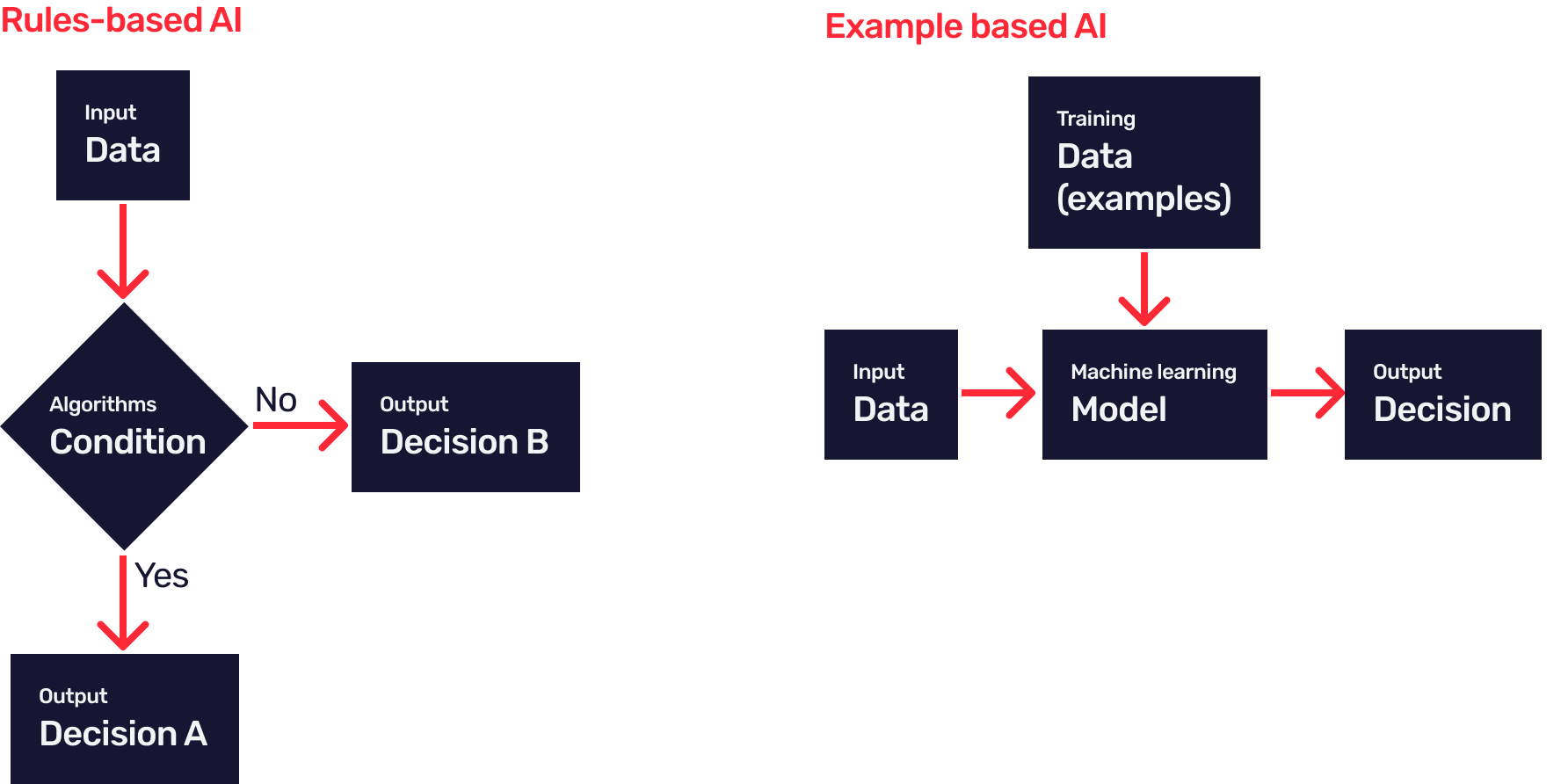
Data, AI and the User: Designing a Win-Win Relationship
Artificial intelligence (AI) and machine learning are terms we encounter more and more in our everyday lives. But how does artificial intelligence actually work? What benefits and considerations are there when creating or using solutions based on AI? And how do you design AI-based solutions in an ethical way while achieving your goals?
Let’s answer those questions.
What is artificial intelligence?
When thinking of AI, we often think of movies where a machine simulates human intelligence and thought processes. These films can involve visions of a bright future or a dystopia, but what they have in common is that we’re actually far from that level of AI.
Our current-day AI does artificial narrow intelligence. This means the AI solution focuses on one, narrow task of human intelligence, such as computer vision, natural language processing or robotics.
There are 2 types of AI:
- Rules-based AI
- Example-based AI (aka machine learning)
Rules-based AI means a system learns to make decisions via algorithms. Algorithms are rigid and can only be applied if each step and reaction are known in advance.
Example-based AI uses data or examples to train the machine so it can detect patterns or create models. The machine learns based on the data and training it completes, which is why this is also called machine learning.

Rules-based AI with fixed paths and decisions. Example-based AI with machine learning.
How does machine learning work?
Now, let’s look at machine learning and artificial neural networks
There are 3 different learning models:
- Supervised learning uses labelled data to create predictions. You tell the model what properties something has and what it is (giving it a label). The machine then learns to detect that particular thing or pattern.
- Unsupervised learning involves no labels at all. The system is fed unsorted, unlabelled data and then finds common features and patterns in that input data. These, in turn, are used to form clusters according to common features. Unsupervised learning can also be applied to find outliers or anomalies in the data.
- Reinforcement learning means rewarding wanted behaviour and punishing unwanted behaviour. Through feedback, the system learns how to find the optimal behaviour or output decision for a certain situation.

Supervised, unsupervised and reinforcement learning are different models of machine learning.
If lots of data is involved and the system needs to find deeper connections inside the data, so-called deep learning with neural networks is applied. Neural networks are a set of artificial neurons imitating the way our human brain communicates. There are input nodes (one or several layers of hidden nodes) and a set of output nodes to generate a decision in the end. These complex solutions enable, for example, self-driving cars or machine vision to detect the usefulness of a plant so farmers can maximise their crops.

OpenAI & Cloud: 2 Use Cases We Built & What We Learned
Check out the two use cases we’ve been working on for AI in the cloud and what we’ve learned.
Designing for AI: Prioritise the user, not the machine
Amid all the considerations and frameworks for designing with AI, there is one primary rule: always put the user first.
Solutions involving AI must always address user needs over certain technical restrictions or requirements. No matter the project goals or financial/technical circumstances, this rule can’t be broken.
When designing for AI, you design a relationship between the user and the machine. AI needs to have constant interaction to be able to help people reach their goals and learn from that interaction to make the best decisions. Like a human relationship, the user/machine relationship is based on trust. Data security and high-quality results from the machine, as well as the user always being in control, enable this trust to grow.
The AI system should also provide the user with new capabilities, thereby creating value for the user. A clear purpose for why the user should engage with the system has to be guaranteed, and that purpose can evolve as the user/system interactions evolve and grow with time.
“When designing for AI, you design a relationship
between the user and the machine.”
Start by aligning business and user intents – then look at data and feasibility
In terms of the process of designing for AI, you must first align the business and user intents for a solution. You should use data from various sources, cleaning it and documenting it so it can be implemented. You need to understand the data required to teach the AI and the type of learning that should be used.
Then, check the emerging plan for feasibility and reasoning: can it actually be realised this way? As a designer, my fellow developers, product owners and other stakeholders are always good sources of information to help me create a feasible solution.
Next, consider ethics and focus on building trust
Once you have a more concrete understanding of the AI solution, you should consider its direct and indirect effects. This means looking at every possible angle for using the system, asking: “What effects will the AI system have on the world?”
Ethical considerations start with the people involved in the different phases of the project; product owners, designers, developers, project managers and other stakeholders each have their own responsibility in this regard. Being accountable is as important as aligning with the intended user group’s values. If you don’t comply with local norms and values, users will reject the AI solution. The AI system’s decision-making and reasoning need to be transparent to the user, and a record should be available for review when needed.
Minimising bias and maximising diversity are also big ethical design factors. You can avoid bias by training the system with diverse data sets, utilising user feedback, having regular reviews as well as working in diverse teams.
User rights to their personal data must be considered as well. Legislation like GDPR in Europe and CCPA in California provide legal frameworks for this. Giving the user a choice or opt-in – and being transparent about data processing and data security – are important design choices to ensure an AI solution design is ethical.

OpenAI Integration Services
We’re here to help with the integration and utilisation of OpenAI on your cloud platforms, so you can power and scale AI applications effectively.
Ready for the next step in your AI journey?
Nordcloud offers a wide range of services to help you get the most out of AI. For example, coud-based AI solutions can be used to increase efficiency, save costs or become more sustainable.
Using AI to detect patterns and gain deeper insight into your data or to make predictions are only a couple ways you can benefit from AI solutions with Nordcloud. We have a user-centred approach to designing AI services, which can be internal work-related systems or external end-user focused products or services. We take care of user data-related legislation like GDPR, and we handle data safety, storage and transparency. We also help you discover possible ethical limitations and create inclusive, diverse solutions for you and your target users.
We’re here to help with the integration and utilisation of AI on your cloud platforms, allowing your teams and developers to make the most of your tools, services, and infrastructure to power and scale AI applications effectively.
See our OpenAI integration services and get in touch here, we’d love to help.
Get in Touch.
Let’s discuss how we can help with your cloud journey. Our experts are standing by to talk about your migration, modernisation, development and skills challenges.




